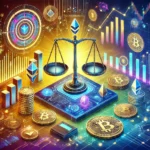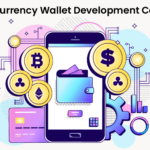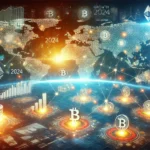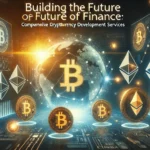As blockchain technology continues to disrupt traditional finance, the integration of Real-World Assets (RWAs) into the crypto ecosystem has emerged as one of the most transformative trends of the decade. Real-World Assets (RWA) Integration: Bridging Blockchain and Tangible Assets. This concept involves tokenizing tangible assets—such as real estate, commodities, and securities—on blockchain platforms, enabling enhanced liquidity, accessibility, and transparency. This blog explores the nuances of RWA integration, the technologies driving it, its implications for investors and institutions, and why it’s becoming a cornerstone of the blockchain revolution.
Understanding Real-World Asset Integration
Real-world asset integration refers to the process of digitizing physical assets by representing them as tokens on a blockchain. These tokens, often known as security tokens or asset-backed tokens, serve as digital certificates of ownership or claims on the underlying asset.
For example:
- A building can be tokenized so that each token represents a fractional ownership stake.
- Gold reserves can be tokenized, enabling them to be traded on decentralized exchanges.
Key Drivers of RWA Integration
Several factors are fueling the adoption and expansion of RWAs in blockchain ecosystems:
1. Enhanced Liquidity
Traditional assets often suffer from illiquidity, requiring significant time and effort to buy or sell. Tokenization eliminates this barrier by enabling fractional ownership and real-time trading on blockchain networks.
2. Democratized Access
Tokenized assets allow smaller investors to gain exposure to previously inaccessible markets. For example, a tokenized piece of prime real estate enables participation by individuals without the need for millions of dollars upfront.
3. Transparency and Security
Blockchain technology provides an immutable and transparent ledger for transactions, ensuring trust among participants. Smart contracts automate processes like dividend payments, reducing reliance on intermediaries.
4. Cost Efficiency
Eliminating middlemen and automating processes reduces transaction costs significantly. Real-World Assets (RWA) Integration: Bridging Blockchain and Tangible Assets. From property management fees to stockbroker commissions, tokenization minimizes these expenses.
5. Cross-Border Investment Opportunities
Tokenized assets can be traded globally with minimal friction, allowing investors to explore diverse opportunities regardless of geographic constraints.
Types of Real-World Assets Being Tokenized
1. Real Estate
Tokenized real estate is one of the most prominent use cases, allowing fractional ownership of residential, commercial, and industrial properties.
- Example: Investors can buy tokens representing shares in luxury apartments, earning rental income proportional to their stake.
2. Commodities
Precious metals like gold and silver, as well as natural resources like oil and gas, are being tokenized.
- Example: A tokenized gold bar enables users to trade ownership of physical gold without the need for physical storage.
3. Financial Instruments
Bonds, equities, and other financial securities are being digitized to enhance trading efficiency.
- Example: Governments and corporations issue tokenized bonds to attract a global pool of investors.
4. Intellectual Property
Intangible assets, including patents, copyrights, and trademarks, are being tokenized to monetize and trade their value more efficiently.
How RWA Integration Works
1. Asset Digitization
A physical asset is represented digitally on the blockchain. For instance, a real estate property may be appraised, and its value is divided into digital tokens.
2. Issuance of Tokens
The owner issues tokens through a blockchain protocol, detailing ownership rights, governance, and profit-sharing mechanisms.
3. Smart Contracts
Smart contracts ensure automated execution of terms, such as revenue distribution, compliance, and asset transfer upon sale.
4. Custodial Services
Physical assets are often secured with custodians, ensuring their backing for the issued tokens.
Challenges in RWA Integration
Despite its potential, RWA integration faces several hurdles:
1. Regulatory Uncertainty
Tokenizing assets often brings legal and compliance complexities, particularly around securities regulations.
2. Valuation Discrepancies
Ensuring the accurate valuation of physical assets for tokenization can be challenging, particularly for unique items like art.
3. Custody Risks
Ensuring the safe storage and management of physical assets tied to tokens is a critical concern.
4. Adoption Barriers
Traditional financial institutions and asset holders may resist blockchain adoption due to unfamiliarity or skepticism.
Use Cases and Real-World Examples
1. Property Markets
Projects like RealT tokenize real estate, allowing investors to own fractional shares in rental properties and receive a portion of rental income.
2. Commodities Trading
Platforms like Tether Gold issue tokens representing physical gold reserves, combining the benefits of gold ownership with the efficiency of blockchain.
3. Art and Collectibles
Platforms like Maecenas enable fractional ownership of high-value art pieces, democratizing the art investment space.
4. Carbon Credits
Tokenizing carbon credits enhances transparency and efficiency in the carbon trading market, attracting more participants to green initiatives.
The Future of RWA Integration
1. Institutional Adoption
With financial giants like BlackRock and Fidelity exploring tokenized markets, the adoption of RWAs is likely to gain momentum.
2. Blockchain Innovations
Layer 2 solutions and cross-chain protocols are enhancing the scalability and interoperability of RWA platforms.
3. Emerging Markets
Tokenization is opening doors for asset-rich but liquidity-poor economies to attract global investments.
4. Regulatory Frameworks
As governments worldwide develop clearer frameworks for digital assets, the potential for RWAs will expand exponentially.
Conclusion: The Rise of RWAs in Blockchain
Real-World Asset integration represents a critical step in bridging traditional finance with blockchain innovation. By enabling fractional ownership, enhancing liquidity, and reducing barriers to entry, RWAs are reshaping investment opportunities across the globe. Despite challenges, advancements in technology and regulatory support are paving the way for RWAs to become a cornerstone of the digital economy.
Whether you’re an investor, entrepreneur, or technologist, the world of tokenized assets offers a wealth of opportunities. The integration of RWAs is not just a trend—it’s a revolution in how we perceive, manage, and interact with tangible assets.






















0 Comments